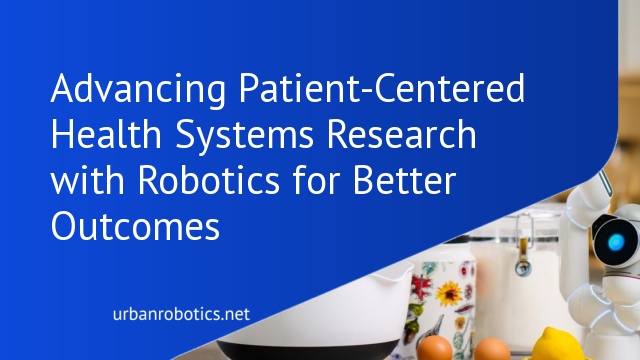Understanding Patient-Centered Health Systems
Patient-centered health systems focus on addressing patient needs, preferences, and values. Integrating robotics emphasizes precision and efficiency in these systems.
The Importance of Patient-Centered Care
Patient-centered care improves outcomes and enhances patient satisfaction. The approach prioritizes personalized treatment plans that match patient preferences. Benefits include increased adherence to medical advice and better overall health. According to a Harvard study, patient-centered care correlates with lower healthcare costs due to fewer unnecessary tests and procedures.
Traditional Health Systems vs. Patient-Centered Models
Traditional health systems often operate on standardized protocols, limiting personalized care. In contrast, patient-centered models tailor treatments to individual needs. Traditional systems can lead to lower patient satisfaction and adherence. On the other hand, patient-centered models, supported by robotics, ensure more accurate diagnoses and treatments, leading to improved health outcomes.
The Role of Robotics in Healthcare
Robotics in healthcare is transforming how patient-centered care is delivered. This technology enhances precision, efficiency, and personalization in treatments.
Types of Healthcare Robots
Several types of robots are utilized in healthcare. Surgical robots, such as the da Vinci system, enable minimally invasive procedures. Rehabilitation robots assist patients in physical therapy, providing consistent and precise exercises. Pharmaceutical robots manage medication dispensing, ensuring accurate dosages. Assistive robots support daily activities for disabled or elderly patients. Diagnostic robots streamline testing and lab work, reducing human error and speeding up results.
Advantages of Robotics in Patient Care
Robotics offers significant benefits in patient care. Improved precision in surgical procedures reduces recovery times and complications. Enhanced efficiency in hospitals optimizes resource use and shortens patient wait times. The consistency of robotic interventions ensures accurate diagnosis and treatment. Robotics also supports personalized care plans by adjusting treatments based on real-time data.
Integration of Robotics in Patient-Centered Health Systems Research
Integrating robotics into patient-centered health systems research is reshaping how medical care is delivered. By focusing on individual patient needs, robotics enhance precision, efficiency, and overall outcomes.
Current Research and Innovations
Ongoing research highlights innovations in robotic surgery, rehabilitation, and diagnostic devices. Studies indicate that robotic surgery reduces recovery times and complications (Journal of Robotic Surgery, 2022). Rehabilitation robots, like exoskeletons, improve mobility for stroke and spinal injury patients (Frontiers in Neurology, 2021). Diagnostic robots using AI algorithms enhance early detection of diseases, streamlining treatment planning.
Challenges and Considerations
Several challenges must be addressed before widespread adoption of robotics in patient-centered health systems. High costs and maintenance of robotic equipment can strain healthcare budgets. Additionally, integrating robotics with existing health infrastructure requires significant training for medical staff. Data privacy concerns also arise, as robotics often involve patient data collection and analysis. Developing standards and frameworks is crucial for mitigating these challenges.
Case Studies and Real-World Applications
Examining case studies and real-world applications reveals the tangible impacts of robotics in patient-centered health systems. These instances demonstrate the potential and challenges faced in practical deployments.
Successful Implementations
One notable example is the da Vinci Surgical System, which has transformed minimally invasive surgeries. This system provides surgeons with enhanced precision and control, significantly reducing recovery times and surgical complications. Another successful case is the use of robotic exoskeletons in rehabilitation, which helps patients regain mobility more effectively. Hospitals worldwide, such as Mayo Clinic and Cleveland Clinic, have integrated these technologies into their practices with remarkable success.
Lessons Learned
From the implementation of robotic systems, we’ve identified several key lessons. Interdisciplinary collaboration is crucial; involving engineers, medical professionals, and IT experts leads to more effective solutions. Additionally, ongoing training for staff ensures that they are proficient in using these advanced technologies. Addressing data privacy concerns early on avoids regulatory pitfalls and maintains patient trust. Understanding these lessons helps in overcoming barriers and optimizing future deployments.
Ethical and Societal Implications
Robotics in patient-centered health systems research brings important ethical and societal considerations we must address.
Patient Privacy and Data Security
Patient data security and privacy are crucial in robotic healthcare. Robotics involves collecting and analyzing vast amounts of sensitive patient information. Protecting this data requires robust encryption and strict access controls. Legal frameworks such as HIPAA in the US mandate these protections. Breaches could compromise patient trust, making stringent cybersecurity measures essential to safeguarding personal health information.
Equity and Accessibility in Robotic Healthcare
Ensuring equity and accessibility in robotic healthcare is essential. High costs and advanced technology can limit access to these innovations. Policy interventions and subsidies are necessary to bridge this gap. Initiatives like community health programs and partnerships with non-profits can promote equitable distribution. Addressing these disparities ensures that all patients benefit from advanced robotic technologies, regardless of socio-economic status.
Conclusion
Embracing robotics in patient-centered health systems offers a promising path to enhanced precision and efficiency in medical procedures. While real-world implementations like the da Vinci Surgical System showcase the potential, it’s crucial to address interdisciplinary collaboration and staff training to maximize benefits.
As we move forward, safeguarding patient privacy and ensuring data security remain paramount. We must also strive for equity and accessibility in robotic healthcare to avoid widening disparities. Policy interventions and community health programs can play pivotal roles in achieving these goals. By focusing on these critical aspects, we can create a more inclusive and effective healthcare system for all.





